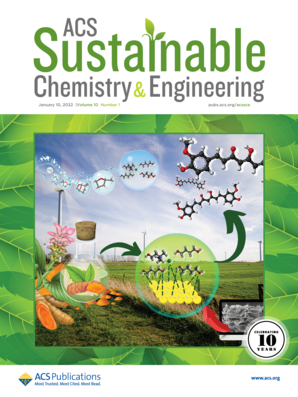Constructing a Multifunctional Sandwich-Structured Sulfur Host To Enhance Energy Density and Cycling Life in Lithium–Sulfur Battery
IF 7.1
1区 化学
Q1 CHEMISTRY, MULTIDISCIPLINARY
引用次数: 0
Abstract
Lithium–sulfur (Li–S) batteries are recognized as promising next-generation energy storage devices due to their high theoretical energy density (2600 Wh kg–1). However, their practical applications still face challenges, such as low S utilization and short cycling life, primarily attributed to the notorious shuttle effect of lithium polysulfides (LiPSs) and sluggish redox kinetics. To address these issues, rationally designing and synthesizing a novel multifunctional S host that acts as a capturer, catalyst, and conductor is considered to be an effective strategy. Herein, we synthesized a unique sandwich-structured S host for the first time (designated as S/VS2–NCNTs), where the network-like conductive nitrogen-doped carbon nanotubes (NCNTs) uniformly coat the surface of few-layer two-dimensional (2D) VS2 nanosheets, preventing 2D VS2 stacking. This sandwich structure exhibits excellent adsorptive, catalytic, and conductive properties toward LiPSs, enhancing redox kinetics via the rapid e–/Li+ transfer/diffusion. Benefiting from these superior properties, the electrochemical performances of Li–S batteries are significantly improved. At a high rate of 2 C, after 1000 ultralong and stable cycles, the capacity remains at 805.9 mAh g–1, with an ultralow decay rate of 0.021% per cycle in coin batteries. Notably, even under high S loading (7.2 mg cm–2, S content of 89 wt %) and limited electrolyte (E/S ratio of 5.1 μL mg–1), it achieves a high areal capacity of 4.76 mAh cm–2 (specific capacity of 703.4 mAh g–1, volume capacities of 719.6 mAh cm–3) after 200 cycles at 0.5 C. More strikingly, for pouch batteries, it maintains a specific capacity of 614.6 mAh g–1 after 200 cycles at 1 C. The design and development of a novel multifunctional S host represent a promising strategy to enhance S utilization and extend long-cycle life in high-energy-density Li–S battery

构建多功能三明治结构硫宿主提高锂硫电池能量密度和循环寿命
锂硫(li -硫)电池因其较高的理论能量密度(2600 Wh kg-1)而被认为是有前途的下一代储能设备。然而,它们的实际应用仍然面临挑战,例如低S利用率和短循环寿命,主要归因于多硫化锂(LiPSs)臭名昭著的穿梭效应和缓慢的氧化还原动力学。为了解决这些问题,合理设计和合成一种新型多功能S宿主,作为捕获,催化剂和导体被认为是一个有效的策略。在此,我们首次合成了一种独特的三明治结构的S宿主(命名为S/VS2 - NCNTs),其中网状的导电氮掺杂碳纳米管(NCNTs)均匀地涂覆在几层二维(2D) VS2纳米片的表面,防止了二维VS2的堆叠。这种夹层结构对LiPSs具有优异的吸附、催化和导电性能,通过快速的e - /Li+转移/扩散增强了氧化还原动力学。得益于这些优越的性能,锂硫电池的电化学性能得到了显著提高。在2℃的高倍率下,经过1000次超长稳定循环后,容量保持在805.9 mAh g-1,硬币电池每循环的衰减率为0.021%。值得注意的是,即使在高S负载(7.2 mg cm-2, S含量为89 wt %)和有限的电解质(E/S比为5.1 μL mg - 1)下,在0.5 c下循环200次后,它也能获得4.76 mAh cm-2的高面积容量(比容量为703.4 mAh g-1,体积容量为719.6 mAh cm-3)。在1℃下循环200次后,其比容量仍保持在614.6 mAh g-1。新型多功能S宿主的设计和开发为提高S利用率和延长高能量密度Li-S电池的长循环寿命提供了一种有前途的策略
本文章由计算机程序翻译,如有差异,请以英文原文为准。
求助全文
约1分钟内获得全文
求助全文
来源期刊

ACS Sustainable Chemistry & Engineering
CHEMISTRY, MULTIDISCIPLINARY-ENGINEERING, CHEMICAL
CiteScore
13.80
自引率
4.80%
发文量
1470
审稿时长
1.7 months
期刊介绍:
ACS Sustainable Chemistry & Engineering is a prestigious weekly peer-reviewed scientific journal published by the American Chemical Society. Dedicated to advancing the principles of green chemistry and green engineering, it covers a wide array of research topics including green chemistry, green engineering, biomass, alternative energy, and life cycle assessment.
The journal welcomes submissions in various formats, including Letters, Articles, Features, and Perspectives (Reviews), that address the challenges of sustainability in the chemical enterprise and contribute to the advancement of sustainable practices. Join us in shaping the future of sustainable chemistry and engineering.
 求助内容:
求助内容: 应助结果提醒方式:
应助结果提醒方式:


